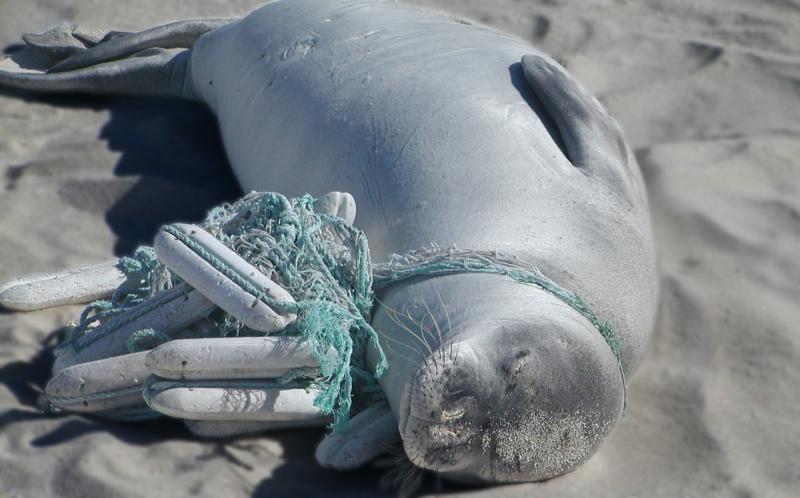A NOAA-led team of marine mammal responders removed an estimated 2,300–2,500 feet of heavy gauge line from an entangled adult humpback whale first spotted off Po‘ipū, Kauaʻi in January.
A community member reported the entanglement to NOAA officials on January 16, 2022. NOAA mobilized a same-day joint response in coordination with the Hawaiʻi Department of Land and Natural Resources (DLNR) and the U.S. Coast Guard.
The humpback whale was emaciated, light-colored, and rough-skinned, with patches of whale lice—all indicative of a whale in distress. There was a large amount of gear trailing behind the whale, and responders have confirmed some of the gear originated from the whale’s mouth. Mouth entanglements are especially dangerous for whales, as they often impact the animal’s ability to feed and otherwise negatively affect the animals.
As of January 28, 2022, the whale's body condition had decreased significantly. The team observed that the whale was very emaciated and rust-colored whale lice nearly covered its entire body.
While the whale’s future is unknown, it hopefully is under less stress and has a better chance of survival now that we’ve removed the majority of the line. Responders will continue to study the gear to determine its identity and possible origin.
Our goal is to safely free large whales from life-threatening entanglements. At the same time, we try to gather valuable information that will reduce the frequency and impacts of entanglements in the future.
Check out photos from the humpback whale response effort
Response Efforts
January 16, 2022
Trained NOAA and DLNR responders mounted an initial, same-day response and were able to remove a majority of the gear trailing from the whale. However, because of the complexity of the entanglement, they were not able to remove all of it. They attached a satellite and Very High Frequency, or VHF, telemetry buoy to aid in tracking the whale for possible follow-up disentanglement attempts. The telemetry buoy is configured to self-release in approximately 10 days avoiding any additional impact to the whale.
January 17, 2022
The team mounted a second response; however, the whale moved away from Kauaʻi to Niʻihau. The team was unable to reach the whale due to the greater distance and the whale’s increase in speed.
January 19, 2022
Data from our telemetry buoy indicated the whale was navigating around Kauaʻi. The team mounted a third effort from Kauaʻi aboard a U.S. Coast Guard vessel. However, after extensive effort, they were unable to sight the whale.
January 20, 2022
Telemetry data indicated the whale was still navigating around Kauaʻi. The team mounted a fourth effort from Kauaʻi aboard a U.S. Coast Guard vessel. However, again after extensive effort, they were unable to sight the whale.
January 21-26, 2022
The whale remained in the vicinity of Niʻihau and Kaʻula. The team was unable to respond because the whale was either too far from Kauaʻi or high winds and seas prevented small boat operations.
January 26, 2022
No further telemetry tracking of the whale was possible as the telemetry buoy self-released at the prescribed time, to reduce any long-term impact from the buoy itself.
January 28, 2022
The company Wings Over Kauai sighted an entangled whale off the southeast coast of Kauaʻi and contacted NOAA. Our Kauaʻi response team was on scene within 2 hours. The team collected drone and underwater footage, which confirmed this whale as the same entangled whale previously sighted. The underwater footage also helped guide the team's efforts. Using a specialized throwing cutting grapple, the team was able to remove an estimated 300–500 feet of additional line that was trailing from the left side of the whale’s mouth. An estimated 15 feet of line is not possible to remove because of its embedded location at the back of the whale’s mouth.
NOAA coordinates disentanglement efforts under the Marine Mammal Health and Stranding Response Program permit (#18786). These efforts are dependent on the commitment of state and federal agencies, private non-governmental organizations, fishermen, and the community working together.
How Can You Help?
Early reporting is key to successful response efforts. We ask for the public’s help in following these steps if they spot an entangled whale:
- CALL – Call the statewide NOAA Marine Wildlife Hotline at (888) 256-9840 to alert authorized responders. If you do not have cell service, call the U.S. Coast Guard on VHF Channel 16.
- MONITOR – If a response is possible, authorities may ask that you watch the animal from a safe—and legal—distance. Follow the 100-yard or close approach rule. This prohibits approaching humpback whales by any means (including with a drone) within 100 yards, and within 1,000 feet when operating an aircraft.
- DOCUMENT – If possible, take photos and video of the animal and entanglement from a safe—and legal—distance. Again, remember the 100-yard or close approach rule!
- WAIT – Rescue efforts should only be conducted by trained, authorized personnel. For your safety and the whale’s, do not attempt to free a whale on your own. Disentangling a large whale is dangerous. Removing trailing lines and buoys may diminish the chances of freeing the animal of all gear, leaving potentially lethal wraps of line still around the whale.
